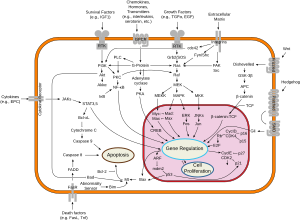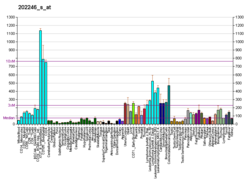사이클린 의존키나제4
Cyclin-dependent kinase 4세포분열단백질키나아제4로도 알려진 사이클린 의존성 키나제4는 인간에서 CDK4 유전자에 의해 암호화된 효소다.CDK4는 사이클린 의존 키나제 계열의 일원이다.
함수
이 유전자가 인코딩한 단백질은 Ser/Tr 단백질 키나아제 계열의 일원이다.이 단백질은 S. 세레비시아 cdc28과 S. 퐁베 cdc2의 유전자 생성물과 매우 유사하다.그것은 세포 주기 G1 위상 진행에 중요한 단백질 키나아제 복합체의 촉매 소단위다.이 키나제의 활성은 규제 서브유닛 D형 사이클린과 CDK 억제제 p16에INK4a 의해 제어되는 G1-S 단계로 제한된다.이 키나아제는 레티노블레스토마 유전자 제품(Rb)의 인산화 작용에 책임이 있는 것으로 나타났다.[4]사이클린 D-CDK4(DC) 복합체의 Ser/Thr-Kinase 성분으로, RB1을 포함한 레티노블레스모종(RB) 단백질 계열의 부재를 인산화 및 억제하고 G1/S 전환 시 셀 사이클을 조절한다.RB1의 인산화 작용은 전사인자 E2F를 RB/E2F 복합체로부터 분리시키고, G1 단계를 통한 진행을 담당하는 E2F 표적 유전자의 후속 전사를 가능하게 한다.G1 초기 단계에서 저인산염 RB1.사이클린 D-CDK4 단지는 다양한 미생물과 항미생성 신호의 주요 통합업체다.또한 SMAD3를 세포 주기 의존적인 방식으로 인지하고 전사 활동을 억제한다.사이클린 D-CDK4 복합체의 핵 변환 및 활동에 필요한 3차 복합체 구성품, 사이클린 D/CDK4/CDK1B.[5]
임상적 유의성
D형 사이클린, p16(INK4a), CDKN2A, Rb를 포함한 관련 단백질뿐만 아니라 이 유전자의 돌연변이는 모두 다양한 암의 종양기세증과 관련이 있는 것으로 밝혀졌다.CDK4(R24C)의 특정 지점 돌연변이는 흑색종 환자에서 처음 확인되었다.이 돌연변이는 동물 모델에도 도입되었고 암 운전자 종양 유전자로서의 역할도 철저히 연구되었다.오늘날에는 규제완화 CDK4가 일부 암유형에서는 잠재적 치료목표로 여겨지고 있으며 다양한 CDK4 억제제가 임상시험에서 암치료에 대해 시험되고 있다.[6][7]
이 유전자의 다중 폴리아데닐화 부위가 보고되었다.[4]
그것은 사이클린 D에 의해 규제된다.
억제제
리보시리브는 미국 FDA가 승인한 에스트로겐 수용체 양성/HER2 음성급 유방암 치료를 위한 CDK4 및 CDK6 억제제다.[8]
다양한 CDK의 억제제는 CDK 억제제를 참조하십시오.
상호작용
Cyclin 의존성 키나제 4가 다음과 상호작용하는 것으로 나타났다.

참조
- ^ a b c GRCh38: 앙상블 릴리스 89: ENSG00000135446 - 앙상블, 2017년 5월
- ^ "Human PubMed Reference:". National Center for Biotechnology Information, U.S. National Library of Medicine.
- ^ "Mouse PubMed Reference:". National Center for Biotechnology Information, U.S. National Library of Medicine.
- ^ a b "Entrez Gene: CDK4 cyclin-dependent kinase 4".
- ^ "CDK4 - Cyclin-dependent kinase 4 - Homo sapiens (Human) - CDK4 gene & protein".
- ^ Sheppard, K. E.; McArthur, G. A. (2013-10-01). "The Cell-Cycle Regulator CDK4: An Emerging Therapeutic Target in Melanoma". Clinical Cancer Research. 19 (19): 5320–5328. doi:10.1158/1078-0432.CCR-13-0259. ISSN 1078-0432. PMID 24089445.
- ^ Sobhani; D’Angelo; Pittacolo; Roviello; Miccoli; Corona; Bernocchi; Generali; Otto (2019-04-06). "Updates on the CDK4/6 Inhibitory Strategy and Combinations in Breast Cancer". Cells. 8 (4): 321. doi:10.3390/cells8040321. ISSN 2073-4409. PMC 6523967. PMID 30959874.
- ^ "Approved Drugs > Ribociclib (Kisqali)". Retrieved 12 September 2017.
- ^ a b c d Ewing RM, Chu P, Elisma F, Li H, Taylor P, Climie S, McBroom-Cerajewski L, Robinson MD, O'Connor L, Li M, Taylor R, Dharsee M, Ho Y, Heilbut A, Moore L, Zhang S, Ornatsky O, Bukhman YV, Ethier M, Sheng Y, Vasilescu J, Abu-Farha M, Lambert JP, Duewel HS, Stewart II, Kuehl B, Hogue K, Colwill K, Gladwish K, Muskat B, Kinach R, Adams SL, Moran MF, Morin GB, Topaloglou T, Figeys D (2007). "Large-scale mapping of human protein-protein interactions by mass spectrometry". Mol. Syst. Biol. 3 (1): 89. doi:10.1038/msb4100134. PMC 1847948. PMID 17353931.
- ^ Dai K, Kobayashi R, Beach D (1996). "Physical interaction of mammalian CDC37 with CDK4". J. Biol. Chem. 271 (36): 22030–4. doi:10.1074/jbc.271.36.22030. PMID 8703009.
- ^ Lamphere L, Fiore F, Xu X, Brizuela L, Keezer S, Sardet C, Draetta GF, Gyuris J (1997). "Interaction between Cdc37 and Cdk4 in human cells". Oncogene. 14 (16): 1999–2004. doi:10.1038/sj.onc.1201036. PMID 9150368.
- ^ Stepanova L, Leng X, Parker SB, Harper JW (1996). "Mammalian p50Cdc37 is a protein kinase-targeting subunit of Hsp90 that binds and stabilizes Cdk4". Genes Dev. 10 (12): 1491–502. doi:10.1101/gad.10.12.1491. PMID 8666233.
- ^ a b c Lin J, Jinno S, Okayama H (2001). "Cdk6-cyclin D3 complex evades inhibition by inhibitor proteins and uniquely controls cell's proliferation competence". Oncogene. 20 (16): 2000–9. doi:10.1038/sj.onc.1204375. PMID 11360184.
- ^ a b Cariou S, Donovan JC, Flanagan WM, Milic A, Bhattacharya N, Slingerland JM (2000). "Down-regulation of p21WAF1/CIP1 or p27Kip1 abrogates antiestrogen-mediated cell cycle arrest in human breast cancer cells". Proc. Natl. Acad. Sci. U.S.A. 97 (16): 9042–6. Bibcode:2000PNAS...97.9042C. doi:10.1073/pnas.160016897. PMC 16818. PMID 10908655.
- ^ a b Rual JF, Venkatesan K, Hao T, Hirozane-Kishikawa T, Dricot A, Li N, Berriz GF, Gibbons FD, Dreze M, Ayivi-Guedehoussou N, Klitgord N, Simon C, Boxem M, Milstein S, Rosenberg J, Goldberg DS, Zhang LV, Wong SL, Franklin G, Li S, Albala JS, Lim J, Fraughton C, Llamosas E, Cevik S, Bex C, Lamesch P, Sikorski RS, Vandenhaute J, Zoghbi HY, Smolyar A, Bosak S, Sequerra R, Doucette-Stamm L, Cusick ME, Hill DE, Roth FP, Vidal M (2005). "Towards a proteome-scale map of the human protein-protein interaction network". Nature. 437 (7062): 1173–8. Bibcode:2005Natur.437.1173R. doi:10.1038/nature04209. PMID 16189514. S2CID 4427026.
- ^ Ghavidel A, Cagney G, Emili A (2005). "A skeleton of the human protein interactome". Cell. 122 (6): 830–2. doi:10.1016/j.cell.2005.09.006. PMID 16179252. S2CID 7410135.
- ^ Guan KL, Jenkins CW, Li Y, Nichols MA, Wu X, O'Keefe CL, Matera AG, Xiong Y (1994). "Growth suppression by p18, a p16INK4/MTS1- and p14INK4B/MTS2-related CDK6 inhibitor, correlates with wild-type pRb function". Genes Dev. 8 (24): 2939–52. doi:10.1101/gad.8.24.2939. PMID 8001816.
- ^ Wang H, Iakova P, Wilde M, Welm A, Goode T, Roesler WJ, Timchenko NA (2001). "C/EBPalpha arrests cell proliferation through direct inhibition of Cdk2 and Cdk4". Mol. Cell. 8 (4): 817–28. doi:10.1016/S1097-2765(01)00366-5. PMID 11684017.
- ^ a b c Sugimoto M, Nakamura T, Ohtani N, Hampson L, Hampson IN, Shimamoto A, Furuichi Y, Okumura K, Niwa S, Taya Y, Hara E (1999). "Regulation of CDK4 activity by a novel CDK4-binding protein, p34(SEI-1)". Genes Dev. 13 (22): 3027–33. doi:10.1101/gad.13.22.3027. PMC 317153. PMID 10580009.
- ^ a b c Nasmyth K, Hunt T (1993). "Cell cycle. Dams and sluices". Nature. 366 (6456): 634–5. doi:10.1038/366634a0. PMID 8259207. S2CID 4270052.
- ^ Taulés M, Rius E, Talaya D, López-Girona A, Bachs O, Agell N (1998). "Calmodulin is essential for cyclin-dependent kinase 4 (Cdk4) activity and nuclear accumulation of cyclin D1-Cdk4 during G1". J. Biol. Chem. 273 (50): 33279–86. doi:10.1074/jbc.273.50.33279. PMID 9837900.
- ^ a b Coleman KG, Wautlet BS, Morrissey D, Mulheron J, Sedman SA, Brinkley P, Price S, Webster KR (1997). "Identification of CDK4 sequences involved in cyclin D1 and p16 binding". J. Biol. Chem. 272 (30): 18869–74. doi:10.1074/jbc.272.30.18869. PMID 9228064.
- ^ Arsenijevic T, Degraef C, Dumont JE, Roger PP, Pirson I (2004). "A novel partner for D-type cyclins: protein kinase A-anchoring protein AKAP95". Biochem. J. 378 (Pt 2): 673–9. doi:10.1042/BJ20031765. PMC 1223988. PMID 14641107.
- ^ Zhang Q, Wang X, Wolgemuth DJ (1999). "Developmentally regulated expression of cyclin D3 and its potential in vivo interacting proteins during murine gametogenesis". Endocrinology. 140 (6): 2790–800. doi:10.1210/endo.140.6.6756. PMID 10342870.
- ^ Zhang JM, Zhao X, Wei Q, Paterson BM (1999). "Direct inhibition of G(1) cdk kinase activity by MyoD promotes myoblast cell cycle withdrawal and terminal differentiation". EMBO J. 18 (24): 6983–93. doi:10.1093/emboj/18.24.6983. PMC 1171761. PMID 10601020.
- ^ Zhang JM, Wei Q, Zhao X, Paterson BM (1999). "Coupling of the cell cycle and myogenesis through the cyclin D1-dependent interaction of MyoD with cdk4". EMBO J. 18 (4): 926–33. doi:10.1093/emboj/18.4.926. PMC 1171185. PMID 10022835.
- ^ Fåhraeus R, Paramio JM, Ball KL, Laín S, Lane DP (1996). "Inhibition of pRb phosphorylation and cell-cycle progression by a 20-residue peptide derived from p16CDKN2/INK4A" (PDF). Curr. Biol. 6 (1): 84–91. doi:10.1016/S0960-9822(02)00425-6. PMID 8805225. S2CID 23024663.
- ^ a b Li J, Melvin WS, Tsai MD, Muscarella P (2004). "The nuclear protein p34SEI-1 regulates the kinase activity of cyclin-dependent kinase 4 in a concentration-dependent manner". Biochemistry. 43 (14): 4394–9. CiteSeerX 10.1.1.386.140. doi:10.1021/bi035601s. PMID 15065884.
- ^ Xiong Y, Zhang H, Beach D (1993). "Subunit rearrangement of the cyclin-dependent kinases is associated with cellular transformation". Genes Dev. 7 (8): 1572–83. doi:10.1101/gad.7.8.1572. PMID 8101826.
추가 읽기
- Hanks SK (1987). "Homology probing: identification of cDNA clones encoding members of the protein-serine kinase family". Proc. Natl. Acad. Sci. U.S.A. 84 (2): 388–92. Bibcode:1987PNAS...84..388H. doi:10.1073/pnas.84.2.388. PMC 304212. PMID 2948189.
- Hall M; Bates S; Peters G (1995). "Evidence for different modes of action of cyclin-dependent kinase inhibitors: p15 and p16 bind to kinases, p21 and p27 bind to cyclins". Oncogene. 11 (8): 1581–8. PMID 7478582.
- Tassan JP, Jaquenoud M, Léopold P, et al. (1995). "Identification of human cyclin-dependent kinase 8, a putative protein kinase partner for cyclin C". Proc. Natl. Acad. Sci. U.S.A. 92 (19): 8871–5. Bibcode:1995PNAS...92.8871T. doi:10.1073/pnas.92.19.8871. PMC 41069. PMID 7568034.
- Mitchell EL, White GR, Santibanez-Koref MF, et al. (1995). "Mapping of gene loci in the Q13-Q15 region of chromosome 12". Chromosome Res. 3 (4): 261–2. doi:10.1007/BF00713052. PMID 7606365. S2CID 6029915.
- Wölfel T, Hauer M, Schneider J, et al. (1995). "A p16INK4a-insensitive CDK4 mutant targeted by cytolytic T lymphocytes in a human melanoma". Science. 269 (5228): 1281–4. Bibcode:1995Sci...269.1281W. doi:10.1126/science.7652577. PMID 7652577. S2CID 37848897.
- Hirai H, Roussel MF, Kato JY, et al. (1995). "Novel INK4 proteins, p19 and p18, are specific inhibitors of the cyclin D-dependent kinases CDK4 and CDK6". Mol. Cell. Biol. 15 (5): 2672–81. doi:10.1128/MCB.15.5.2672. PMC 230497. PMID 7739547.
- Chan FK, Zhang J, Cheng L, et al. (1995). "Identification of human and mouse p19, a novel CDK4 and CDK6 inhibitor with homology to p16ink4". Mol. Cell. Biol. 15 (5): 2682–8. doi:10.1128/MCB.15.5.2682. PMC 230498. PMID 7739548.
- Guan KL, Jenkins CW, Li Y, et al. (1995). "Growth suppression by p18, a p16INK4/MTS1- and p14INK4B/MTS2-related CDK6 inhibitor, correlates with wild-type pRb function". Genes Dev. 8 (24): 2939–52. doi:10.1101/gad.8.24.2939. PMID 8001816.
- Kato JY; Matsuoka M; Strom DK; Sherr CJ (1994). "Regulation of cyclin D-dependent kinase 4 (cdk4) by cdk4-activating kinase". Mol. Cell. Biol. 14 (4): 2713–21. doi:10.1128/MCB.14.4.2713. PMC 358637. PMID 8139570.
- Khatib ZA, Matsushime H, Valentine M, et al. (1993). "Coamplification of the CDK4 gene with MDM2 and GLI in human sarcomas". Cancer Res. 53 (22): 5535–41. PMID 8221695.
- Serrano M; Hannon GJ; Beach D (1994). "A new regulatory motif in cell-cycle control causing specific inhibition of cyclin D/CDK4". Nature. 366 (6456): 704–7. Bibcode:1993Natur.366..704S. doi:10.1038/366704a0. PMID 8259215. S2CID 4368128.
- Demetrick DJ; Zhang H; Beach DH (1994). "Chromosomal mapping of human CDK2, CDK4, and CDK5 cell cycle kinase genes". Cytogenet. Cell Genet. 66 (1): 72–4. doi:10.1159/000133669. PMID 8275715.
- Kato J, Matsushime H, Hiebert SW, et al. (1993). "Direct binding of cyclin D to the retinoblastoma gene product (pRb) and pRb phosphorylation by the cyclin D-dependent kinase CDK4". Genes Dev. 7 (3): 331–42. doi:10.1101/gad.7.3.331. PMID 8449399.
- Zuo L, Weger J, Yang Q, et al. (1996). "Germline mutations in the p16INK4a binding domain of CDK4 in familial melanoma". Nat. Genet. 12 (1): 97–9. doi:10.1038/ng0196-97. PMID 8528263. S2CID 29727436.
- Andersson B, Wentland MA, Ricafrente JY, et al. (1996). "A "double adaptor" method for improved shotgun library construction". Anal. Biochem. 236 (1): 107–13. doi:10.1006/abio.1996.0138. PMID 8619474.
- Knudsen ES; Wang JY (1996). "Differential regulation of retinoblastoma protein function by specific Cdk phosphorylation sites". J. Biol. Chem. 271 (14): 8313–20. doi:10.1074/jbc.271.14.8313. PMID 8626527.
- Poon RY; Jiang W; Toyoshima H; Hunter T (1996). "Cyclin-dependent kinases are inactivated by a combination of p21 and Thr-14/Tyr-15 phosphorylation after UV-induced DNA damage". J. Biol. Chem. 271 (22): 13283–91. doi:10.1074/jbc.271.22.13283. PMID 8662825.
- Stepanova L; Leng X; Parker SB; Harper JW (1996). "Mammalian p50Cdc37 is a protein kinase-targeting subunit of Hsp90 that binds and stabilizes Cdk4". Genes Dev. 10 (12): 1491–502. doi:10.1101/gad.10.12.1491. PMID 8666233.
- Dai K; Kobayashi R; Beach D (1996). "Physical interaction of mammalian CDC37 with CDK4". J. Biol. Chem. 271 (36): 22030–4. doi:10.1074/jbc.271.36.22030. PMID 8703009.
- Fåhraeus R, Paramio JM, Ball KL, et al. (1996). "Inhibition of pRb phosphorylation and cell-cycle progression by a 20-residue peptide derived from p16CDKN2/INK4A" (PDF). Curr. Biol. 6 (1): 84–91. doi:10.1016/S0960-9822(02)00425-6. PMID 8805225. S2CID 23024663.
외부 링크
- Cyclin-dependent+Kinase+4(미국 국립 의학 라이브러리 의료 과목 제목)
- UCSC 게놈 브라우저에서 CDK4 인간 유전자 위치.
- UCSC 게놈 브라우저의 CDK4 인간 유전자 세부 정보.





